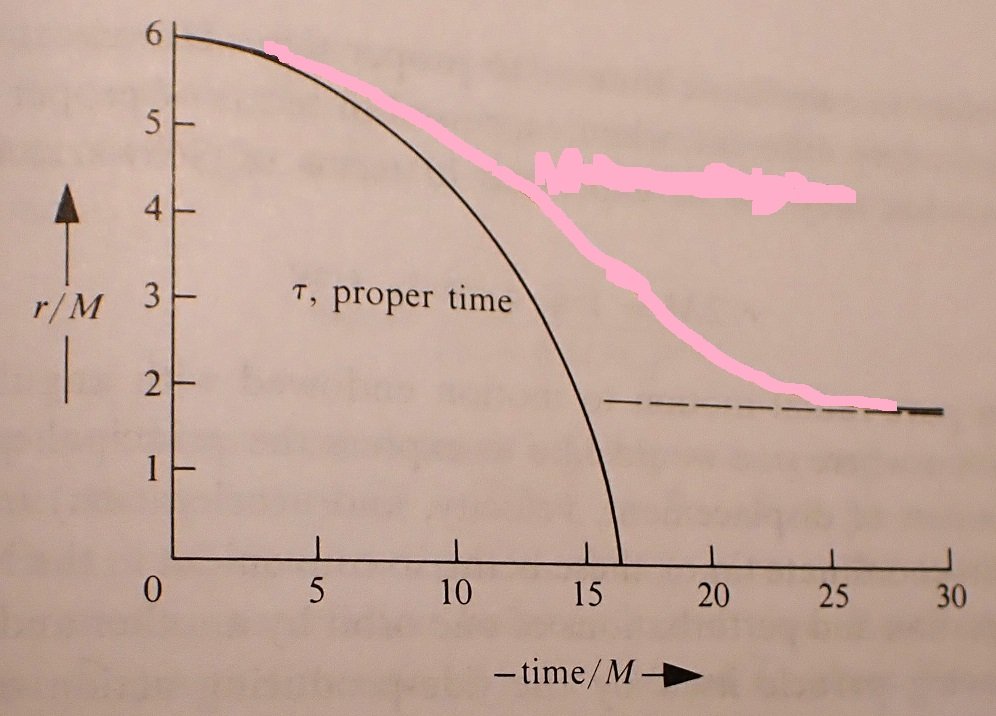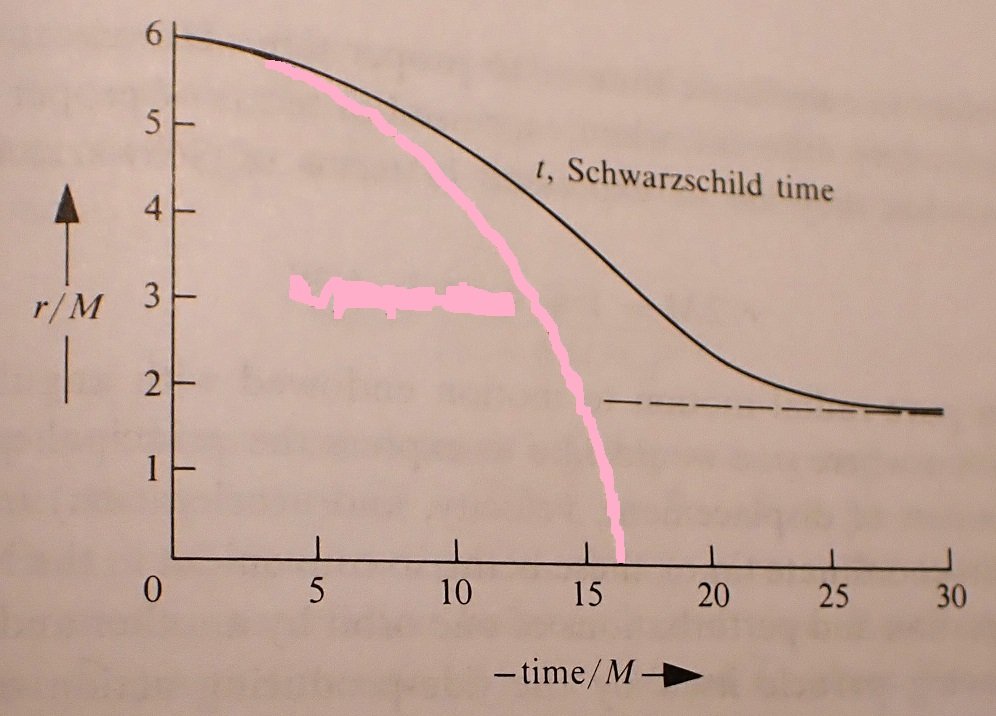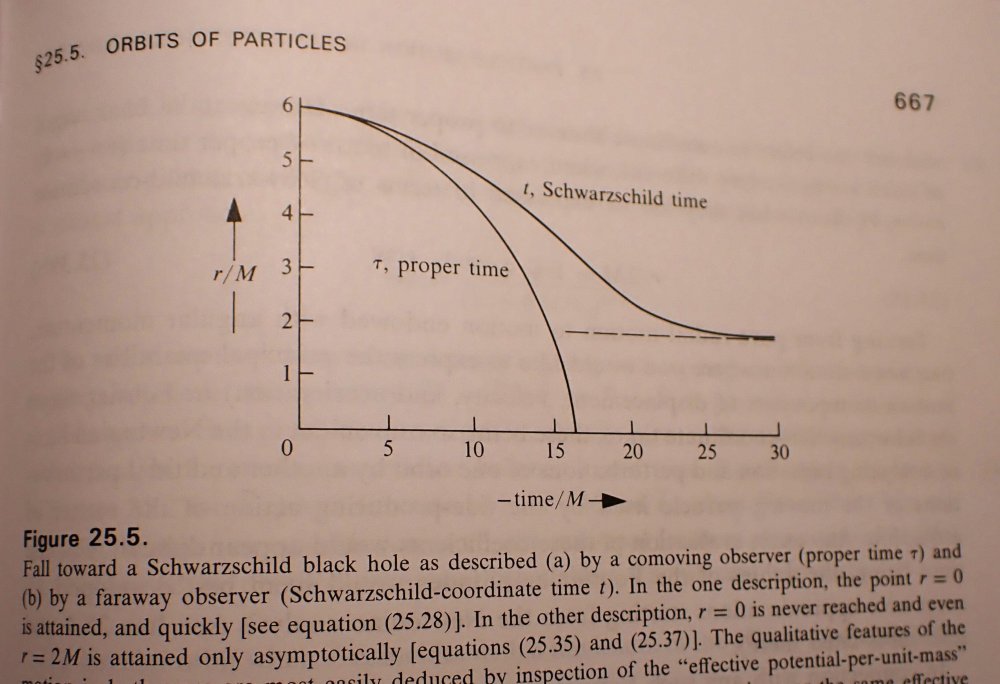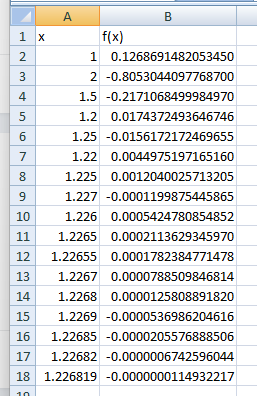-
Posts
5447 -
Joined
-
Days Won
53
Content Type
Profiles
Forums
Events
Everything posted by Genady
-

Does the spacetime curvature according to Einstein really exist?
Genady replied to tmdarkmatter's topic in Speculations
Yes, this is two graphs shown together. One is in the frame of the falling observer. In this graph, "time" is the falling observer's proper time: The falling observer reaches the horizon and the singularity in a finite time. The other is in the frame of the distant observer. In this graph, "time" is the Schwartzschild time of that observer: In this frame, the falling observer never reaches the horizon. -
To the contrary, it will be rather harder.
-

Does the spacetime curvature according to Einstein really exist?
Genady replied to tmdarkmatter's topic in Speculations
The chart below illustrates what happens in two inertial frames as one falls and the other remains far away. Time, in units of the BH mass M, shown on the horizontal axis. Distance from the BH singularity, also in units of the BH mass, shown on the vertical axis. r = 2M (r/M = 2) is the event horizon, shown as a dashed line. The falling observer starts at the distance r = 6M, accelerates and falls through the event horizon and into the singularity in about t = 15.3M, in his own frame. In the stationary observer's frame, OTOH, the falling one accelerates, albeit more slowly, until about t = 20M, then decelerates, slows down to zero asymptotically, and never crosses the horizon. -
Adaptation is not a goal of Darwinian evolution, but one of effects among other effects such as diversification and extinction. Environmental changes are only one of the factors affecting evolution. Evolution happens without environmental changes as well. IMO, it is incorrect to measure efficiency of evolution by time of adaptation to environmental changes. In fact, there is a strong argument that this ability would rather stagnate than accelerate evolution. This is fine. Also, it appears to go in an OT direction. Let's return to your topic then .
-

Does the spacetime curvature according to Einstein really exist?
Genady replied to tmdarkmatter's topic in Speculations
So, do they or don't they cross horizon in this explanation? No, you will not. Once you get there, nothing extraordinary happens. This is not what would happen. Your description is incorrect. -

Does the spacetime curvature according to Einstein really exist?
Genady replied to tmdarkmatter's topic in Speculations
In the proper time of an observer far from the event horizon, a falling object slows down before crossing the horizon and never crosses it. IOW, observed or not, there is no point on the far observer's time axis / clock that would correspond to a moment of the falling object crossing the horizon. -

Does the spacetime curvature according to Einstein really exist?
Genady replied to tmdarkmatter's topic in Speculations
Thanks, I'll read the paper. However, I can't watch videos. -

Does the spacetime curvature according to Einstein really exist?
Genady replied to tmdarkmatter's topic in Speculations
How is described, in this interpretation of GR, slowing of the falling close to BH event horizon? -

Does the spacetime curvature according to Einstein really exist?
Genady replied to tmdarkmatter's topic in Speculations
Nothing new. Just an underdeveloped variation of Le Sage's theory of gravitation - Wikipedia. -
Exactly. This is the difference between this variation of ML on one hand and the Darwinian evolution and the evolution discussed by OP on the other.
-
I think, you were right, and it is a transcendental equation. I've solved it with a very simple approximation procedure and Excel. Here it is: f(x) = (Pi - 2)/4 + sin(x) - x
-
You are right, it is a common view, AFAIK. But I'm not sure, why.
-
Perhaps not fully understood but understood very well. It is rather very efficient. It might seem to be inefficient if one considers it going toward some goal. But it does not. It is extremely efficient on every step of the process. It cannot do it without selection. If "evolution" of AI is not Darwinian, what is it?
-
I understand that making copies and programming these copies are analogous to "descent with modifications". These are necessary but not sufficient components of Darwinian evolution. The other crucial component is selection. What selection will drive this evolution?
-
Let's then take another example: x+2.734=5.31 In this case I am dealing with 5.31 stable virtual particles, and I am seeing 2.734 of them, what I am missing is 2.576 of them? Right? 5.31 particles? 2.734 particles? 2.576 particles? How is it possible? How does 0.3 particle look?
-
Given x+2=5, I conclude that x=3. This is an example of "doing algebra." In what way is it "probing properties of the basic framework(spacetime fabric)?"
-
Area of a sector with angle a in radians and unit radius is a/(2p)*(p*r^2)=a/2 for any a.
-
a=1.226819...
-
I don't need to read your book because I know algebra. If your universe allows FTL, and if causality is not violated in your universe, then algebra shows that special relativity does not apply in your universe. Then your universe is not the universe we live in. The End.
-
Galactic evolution is very far from having a well established mainstream theory. There are several models, each one having open questions. The new data set limits to these models. What is sensational is delivery of the new findings by popular media.
-
New and unpredicted, yes. Sensational and contradicting, no. This is the purpose of this instrument - to deliver new data which were unknown before.
-
The causality violation does not happen to frames. It happens to observers. It does not prevent causality violation.
-
I'm curious to see some examples of these rare cases.
-
The "ship" can be just another planet with people on it. Then causality is violated.
-
Talking of wishful thinking that has been mentioned earlier in this thread. I don't see why we can accept inevitability of our personal death, while have a problem accepting inevitability of death of humanity. Or inevitability of our cosmic isolation until that happens. Perhaps, this question belongs to a thread in a different forum though.





